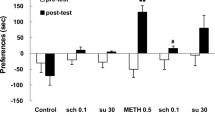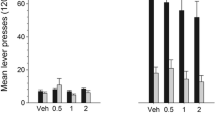Abstract
A study was performed to examine behavioral response to a challenge of selective dopamine D-1 and D-2 agonists in rats previously sensitized by subchronic administration of methamphetamine or cocaine. Rats in three groups received repeated injections (IP) of saline, methamphetamine (4 mg/kg/day) or cocaine (20 mg/kg/day), respectively, for 14 days. After an abstinence period of 7–13 days, all groups were challenged with either a selective D-1 agonist (SKF 38393) or D-2 agonists (quinpirole or RU 24213). The ability of SKF 38393 (6 mg/kg or 18 mg/kg) to produce grooming behavior did not differ significantly among the saline-, methamphetamine-and cocaine-treated groups. In contrast, quinpirole (1 mg/kg) and RU 24213 (3 mg/kg) produced more intense stereotypy consisting of rearing, sniffing and repetitive head movement in the two psychostimulant-treated groups than in the saline-treated group. Such augmented response to selective D-2 agonists was observed even after a 1-month abstinence period. These results suggest that the enduring behavioral sensitization induced by two pharmacologically distinct psychostimulant agents, methamphetamine and cocaine, occurs through a common neurobiological mechanism of lasting supersensitivity in postsynaptic D-2, but not D-1 dopamine receptors.
Similar content being viewed by others
References
Akimoto K, Hamamura T, Otsuki S (1989) Subchronic cocaine treatment enhances cocaine-induced dopamine efflux, studied by in vivo intracerebral dialysis. Brain Res 490:339–344
Akiyama K, Sato M, Otsuki S (1982a) Increased3H-spiperone binding sites in mesolimbic area related to methamphetamine-induced behavioral sensitization. Biol Psychiatry 17:223–231
Akiyama K, Sato M, Kashihara K, Otsuki S (1982b) Lasting changes in high affinity3H-spiperone binding to the rat striatum and mesolimbic area after chronic methamphetamine administration: evaluation of dopaminergic and serotonergic receptor compoonents. Biol Psychiatry 17:1389–1402
Angrist B (1983) Psychosis induced by central nervous system stimulants and related drugs. In: Creese I (eds) Stimulants: neurochemical, behavioral and clinical perspectives. Raven Press, New York, pp 1–30
Braun AR, Chase TN (1986) Obligatory D-1/D-2 receptor interaction in the generation of dopamine agonist related behaviors. Eur J Pharmacol 131:301–306
Burt DR, Creese I, Snyder SH (1977) Antischizophrenic drugs: chronic treatment elevates dopamine receptor binding in brain. Science 196:326–328
Carson JH, Bergstrom DA, Walters JR (1987) Stimulation of both D1 and D2 dopamine receptors necessary for full expression of postsynaptic effects of dopamine agonists: a neurophysiological study. Brain Res 400:205–218
Clark S, Hjorth S, Carlsson A (1985) Dopamine-receptor agonists: mechanisms underlying autoreceptor selectivity. I. Review of the evidence. J Neural Transm 62:1–52
Ellinwood EH, Sudilovski A, Nelson LJ (1973) Evolving behavior in the clinical and experimental amphetamine (model) psychosis. Am J Psychiatry 130:1088–1093
Howlett DR, Nahorski SR (1979) Acute and chronic amphetamine treatments modulate striatal dopamine receptor binding sites. Brain Res 161:173–178
Hulihan-Biblin B, Hauger RL, Janowski A, Paul SM (1985) Dopaminergic denervation increase [3H](+)-amphetamine binding in the rat striatum. Eur J Pharmacol 113:141–142
Jackson DM, Bailey RC, Christie MJ, Crisp EA, Skerritt JH (1981) Long-termd-amphetamine in rats: lack of a change in postsynaptic dopamine receptor sensitivity. Psychopharmacology 73:276–280
Kazahaya Y, Akimoto K, Otsuki S (1989) Subchronic methamphetamine treatment enhances methamphetamine- or cocaine-induced dopamine efflux in vivo. Biol Psychiatry 25:903–912
Klawans HL, Hitri A, Carvey PM, Nausieda PA, Weiner WJ (1979) Effects of chronic dopaminergic agonist on striatal membrane dopamine binding. Adv Neurol 24:217–224
Levy AD, Kim JJ, Ellison GD (1988) Chronic amphetamine alters D-2 but not D-1 agonist-induced behavioral response in rats. Life Sci 43:1207–1213
Mashurano M, Waddington JL (1986) Stereotyped behavior in response to the selective D-2 dopamine receptor agonist RU 24213 is enhanced by pretreatment with the selective D-1 agonist SK&F 38393. Neuropharmacology 25:947–949
Molloy AG, Waddington JL (1984) Dopaminergic behavior stereospecifically promoted by D1 agonist R-SK&F 38393 and selectively blocked by the D1 antagonist SCH 23390. Psychopharmacology 82:409–410
Moore KE (1976) The actions of amphetamine on neurotrans-mitters: a brief review. Biol Psychiatry 12:451–462
Nishikawa T, Mataga N, Takashima M, Toru M (1983) Behavioral sensitization and relative hyperresponsiveness of striatal and limbic dopaminergic neurons after repeated methamphetamine treatment. Eur J Pharmacol 88:190–203
Post RM, Kopanda RT (1976) Cocaine, kindling, and psychosis. Am J Psychiatry 133:627–634
Post RM, Rose H (1976) Increasing effects of repetative cocaine administration in the rat. Nature 260:731–732
Pugh MT, O'Boyle KM, Molloy AG, Waddington JL (1985) Effects of the putative D-1 antagonist SCH 23390 on stereotyped behavior induced by the D-2 agonist RU 24213. Psychopharmacology 87:308–312
Randrup A, Munkvad I (1970) Biochemical, anatomical and psychological investigations of stereotyped behavior induced by amphetamines. In Costa E, Garattini S (eds) Amphetamines and related compounds. Raven Press, New York, pp 695–713
Reith MEA, Meisler BE, Sershen H, Lastha A (1986) Structural requirement for cocaine congeners to interact with dopamine and serotonin uptake site in mouse brain and to induce stereotyped behavior. Biochem Pharmacol 35:1123–1129
Riffee WH, Wilcox RE, Vaughn DM, Smith RV (1982) Dopamine receptor sensitivity after chronic dopamine agonists. Psychopharmacology 77:146–149
Robertson HA (1983) Chronicd-amphetamine and phencyclidine: effects on dopamine agonist and antagonist binding sites in the extrapyramidal and mesolimbic systems. Brain Res 267:179–182
Robinson TE, Becker JB (1986) Enduring changes in brain and behavior produced by chronic amphetamine administration: a review and evaluation of animal models of amphetamine psychosis. Brain Res Rev 11:157–198
Robinson TE, Jurson PA, Bennett JA, Bentgen KM (1988) Persistent sensitization of dopamine neurotransmission in ventral striatum (nucleus accumbens) produced by prior experience with (+)-amphetamine: a microdialysis study in freely moving rats. Brain Res 462:211–222
Sato M, Chen C-C, Akiyama K, Otsuki S (1983) Acute exacerbation of paranoid psychotic state after long-term abstinence in patients with previous methamphetamine psychosis. Biol Psychiatry 18:429–440
Segal DS, Janowski DS (1978) Psychostimulant-induced behavioral effects: possible models of schizophrenia. In: Lipton MA, DiMascio A, Killam KF (eds) Psychopharmacology: a generation of progress. Raven Press, New York, pp 1113–1123
Segal DS, Mandell AJ (1974) Long-term administration ofd-amphetamine: progressive augmentation of motor activity and stereotypy. Pharmacol Biochem Behav 2:249–255
Sharp T, Zetterstöm T, Collin A-K, Ungerstedt U (1987) The D-2 agonist quinpirole releases striatal dopamine in vivo. Eur J Pharmacol 142:187–188
Starr BS, Starr MS (1986) Differential effects of dopamine D1 and D2 agonists and antagonists on velocity of movement, rearing and grooming in the mouse. Neuropharmacology 25:455–463
Trugman JM, Geary II, Wooten GF (1986) Localization of D-2 dopamine receptors to intrinsic striatal neurons by quantitative autoradiography. Nature 323:267–269
Ujike H, Onoue T, Akiyama K, Hamamura T, Otsuki S (1989) Effects of selective D-1 and D-2 dopamine antagonists on development of methamphetamine-induced behavioral sensitization. Psychopharmacology 98:89–92
Walters JR, Bergstrom DA, Carlson JH, Chase TN, Braun AR (1987) D1 dopamine receptor activation required for postsynaptic expression of D2 agonist effects. Science 236:719–722
Author information
Authors and Affiliations
Rights and permissions
About this article
Cite this article
Ujike, H., Akiyama, K. & Otsuki, S. D-2 but not D-1 dopamine agonists produce augmented behavioral response in rats after subchronic treatment with methamphetamine or cocaine. Psychopharmacology 102, 459–464 (1990). https://doi.org/10.1007/BF02247125
Received:
Revised:
Issue Date:
DOI: https://doi.org/10.1007/BF02247125




